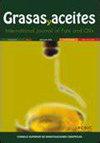椰子油中酚类抗氧化剂:影响数量和质量的因素。回顾
IF 1.1
4区 农林科学
Q4 CHEMISTRY, APPLIED
引用次数: 5
摘要
椰子油中总酚含量(TPC)因提取方法、品种、椰子仁成分性质和产地而异。通常报道的干法和湿法提取椰子油的TPCs分别在70-300 mg/kg和250-650 mg/kg之间。根据通常报道的数据,由于提取方法、椰子品种和籽粒成分性质的影响,椰子油的TPC分别变化高达527 mg/kg油、180 mg/kg油和172 mg/kg油。酚类化合物的性质也随提取方法的不同而不同。咖啡酸、儿茶素、对香豆酸、阿魏酸和丁香酸在用各种方法提取的椰子油中都有不同数量的存在。然而,绿原酸、肉桂酸、表没食子儿茶素、没食子酸、香草酸和表儿茶素只存在于某些椰子油中。橄榄油中存在的许多游离酚类化合物也存在于椰子油中。本文章由计算机程序翻译,如有差异,请以英文原文为准。
Phenolic antioxidants in coconut oil: Factors affecting the quantity and quality. A review
The total phenol content (TPC) in coconut oil varies with extraction method, variety, nature of coconut kernel components and geographical origin. Commonly reported TPCs of coconut oils extracted by dry methods and wet methods are in the range of 70-300 mg/kg and 250-650 mg/kg, respectively. Based on the commonly reported data, the TPC of coconut oil varies by up to 527 mg/kg oil, 180 mg/kg oil, and 172 mg/kg oil due to the influence of the extraction method, coconut variety and the nature of kernel components, respectively. The identity of the phenolic compounds also varies with the extraction method. Caffeic acid, catechin, p-coumaric acid, ferulic acid, and syringic acid are present in different quantities in coconut oil when extracted by all methods. However, chlorogenic acid, cinnamic acid, epigallocatechin, gallic acid, vanillic and epicatechin are present only in some coconut oils. Many free phenolic compounds present in olive oil are also present in coconut oil.
求助全文
通过发布文献求助,成功后即可免费获取论文全文。
去求助
来源期刊

Grasas y Aceites
工程技术-食品科技
CiteScore
2.50
自引率
0.00%
发文量
50
审稿时长
3 months
期刊介绍:
Grasas y Aceites is a peer-reviewed journal devoted to the publication of original articles concerning the broad field of lipids, especially edible fats and oils from different origins, including non acyl lipids from microbial origin relevant to the food industry. It publishes full research articles, research notes, reviews as well as information on references, patents, and books.
Grasas y Aceites publishes original articles on basic or practical research, as well as review articles on lipid related topics in food science and technology, biology, (bio)chemistry, medical science, nutrition, (bio)technology, processing and engineering. Topics at the interface of basic research and applications are encouraged. Manuscripts related to by-products from the oil industry and the handling and treatment of the wastewaters are also welcomed.
Topics of special interest to Grasas y Aceites are:
-Lipid analysis, including sensory analysis
-Oleochemistry, including lipase modified lipids
-Biochemistry and molecular biology of lipids, including genetically modified oil crops and micro-organisms
-Lipids in health and disease, including functional foods and clinical studies
-Technical aspects of oil extraction and refining
-Processing and storage of oleaginous fruit, especially olive pickling
-Agricultural practices in oil crops, when affecting oil yield or quality
 求助内容:
求助内容: 应助结果提醒方式:
应助结果提醒方式:


